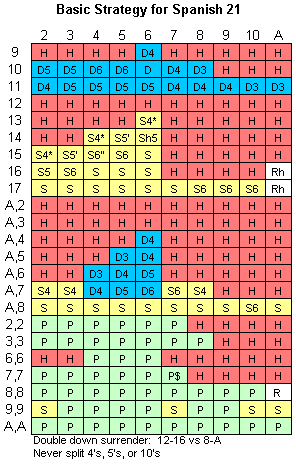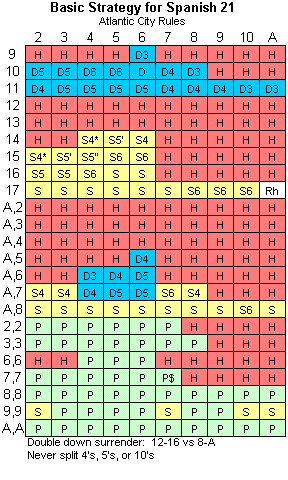|
 Spanish
21 is a variation of regular 21 played without tens in the deck but with more
liberal rules. By 'tens' I mean the card in rank between nines and jacks, all
face cards are still used. For blackjack novices it should be stressed that
taking the tens out of play is very disadvantageous to the player. Any card
counter, myself included, can tell you a deck rich in tens favors the player and
a deck rich in small cards favors the dealer. Spanish
21 is a variation of regular 21 played without tens in the deck but with more
liberal rules. By 'tens' I mean the card in rank between nines and jacks, all
face cards are still used. For blackjack novices it should be stressed that
taking the tens out of play is very disadvantageous to the player. Any card
counter, myself included, can tell you a deck rich in tens favors the player and
a deck rich in small cards favors the dealer.
To compensate for the loss of tens, Spanish 21 offers the following rule
enhancements over regular blackjack:
-
The player may double on any number of cards.
-
Late surrender is allowed. In other words the player may pull out of a
hand by forfeiting half his bet, but only if the dealer does not have a
blackjack.
-
A player 21 always beats a dealer 21.
-
Late surrender is allowed on first two cards.
-
Double down rescue allows player to take back doubled portion of bet and
forfeit the original wager.
-
Player may double after splits.
-
Player may resplit up to three times, including aces.
-
Player may draw and double down to split aces.
-
A five card 21 pays 3:2.
-
A six card 21 pays 2:1.
-
A seven or more card 21 pays 3:1.
-
A 21 consisting of a 6, 7, and 8 of mixed suits pays 3:2.
-
A 21 consisting of a 6, 7, and 8 of matching suit pays 2:1.
-
A 21 consisting of a 6, 7, and 8 of spades pays 3:1.
-
A 21 consisting of three 7's of mixed suits pays 3:2.
-
A 21 consisting of three 7's of matching suits 2:1.
-
A 21 consisting of three 7's of spades pays 3:1.
-
Three suited 7's in addition to the dealer having any 7 face up pays.
$1000 for bets between $5 and $24, and pays $5000 for bets of $25 and over.
In addition all other players get an "envy bonus" of $50.
Note:
1. Dealer usually hits a soft 17 .
2. All 21 bonus hands do not count if the result of doubling or splitting.
3. Six Spanish decks are used (except in Atlantic City where eight decks are
used).
Strategy
Following is my Spanish 21 basic strategy when the dealer hits a soft
17. This strategy is based on a combinatorial analysis and is verified by an
infinite deck model in Excel.

Next is the Spanish 21 basic strategy when the dealer stands on a soft 17.

The following is a key to the table. Capital letters denote the usual play
for a hand unless there is a bonus exception. Exceptions are noted with an h, *,
', ", or $.
|
H |
Hit |
|
S
|
Stand
|
|
D
|
Double
|
|
P
|
Split
|
|
Rh |
Surrender on first two cards, otherwise hit
|
|
3
|
Hit if hand is composed of 3 cards or more
|
|
4
|
Hit if hand is composed of 4 cards or more
|
|
5
|
Hit if hand is composed of 5 cards or more
|
|
6
|
Hit if hand is composed of 6 cards or more
|
|
*
|
Hit if any 6-7-8 bonus possible
|
|
'
|
Hit if suited or spaded 6-7-8 bonus is possible
|
|
"
|
Hit if spaded 6-7-8 bonus is possible
|
|
$ |
Hit if two sevens are suited (possible super bonus) |
If you can not see clearly the symbols for the 6-7-8 bonus exceptions here is
a listing of hands where an exception should be made because of the 6-7-8
incentives.
-
6,7 (any) Vs. 6
-
6,8 (any) Vs. 4
-
6,8 (suited) Vs. 5
-
7,8 (any) Vs. 2
-
7,8 (suited) Vs. 3
-
7,8 (spaded) Vs. 4
House Edge
Following the basic strategy above the house edge in Spanish 21 is
0.69%. However if the dealer stands on a soft 17 the house edge is only 0.34%!
This is lower than the Atlantic City blackjack game at 0.43%.
Where to find the Good Games
Usually the dealer will hit a soft 17 however some casinos offer the
more favorable game in which the dealer stands on all 17's. Locations that I
know of or have heard of where the dealer stands on a soft 17 are:
Match the Dealer
In Atlantic City there is a side bet available in Spanish 21. The bet
pays 3 to 1 if either of the player's first two cards matches the rank but not
the suit of the dealer's up card. The bet pays 12 to 1 if both the rank and suit
match. These odds are payable on both of the player's cards. If there is a match
the side bet always pays even if the player loses the hand. The house edge on
this bet is 2.35% assuming eight decks are used.
|